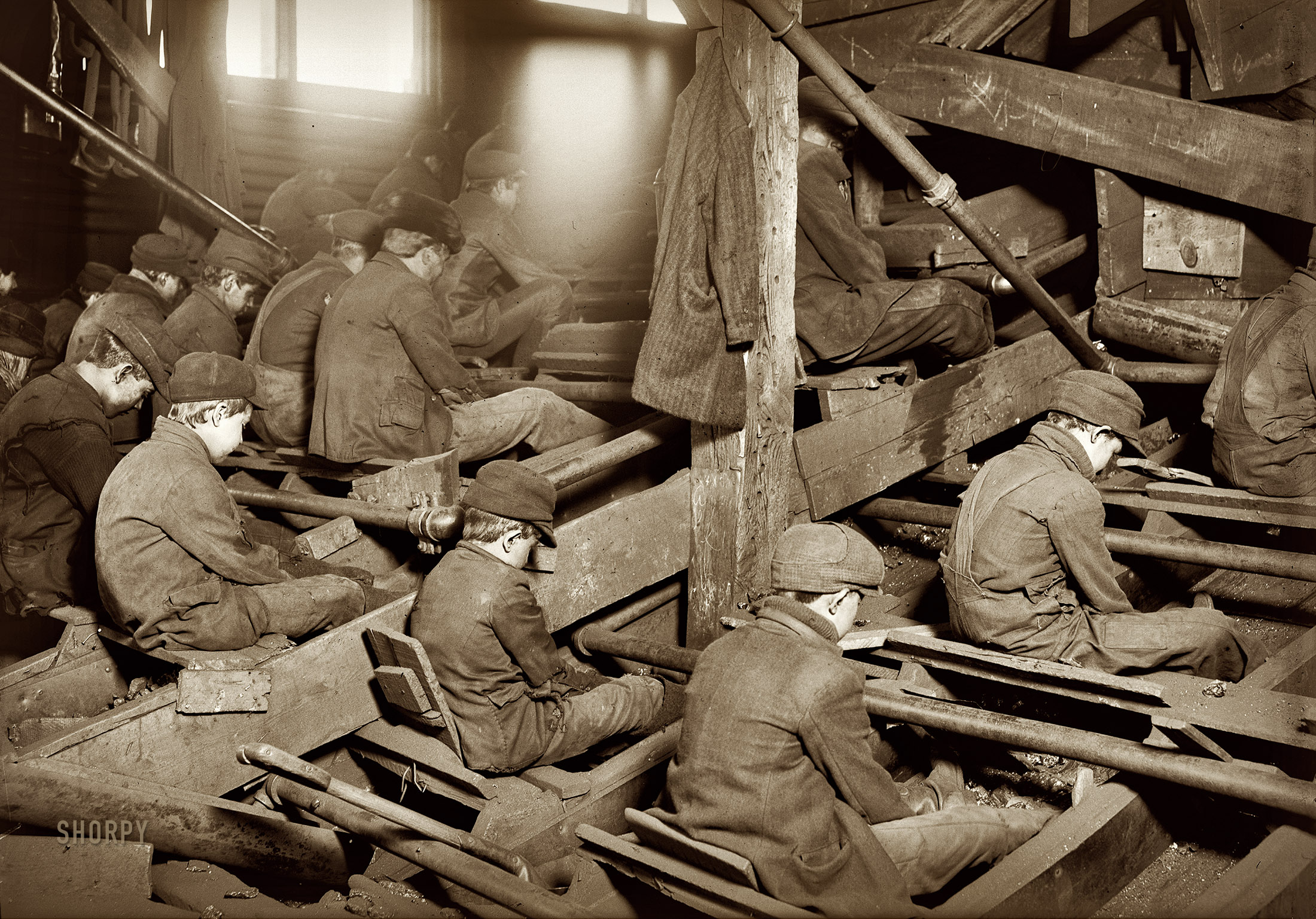
January 1911. South Pittston, Pennsylvania. "A view of the Pennsylvania Breaker. 'Breaker boys' remove rocks and other debris from the coal by hand as it passes beneath them. The dust is so dense at times as to obscure the view and penetrates the utmost recesses of the boys' lungs." Photo by Lewis Wickes Hine.
From the 1906 book The Bitter Cry of the Children by labor reformer John Spargo:
Work in the coal breakers is exceedingly hard and dangerous. Crouched over the chutes, the boys sit hour after hour, picking out the pieces of slate and other refuse from the coal as it rushes past to the washers. From the cramped position they have to assume, most of them become more or less deformed and bent-backed like old men. When a boy has been working for some time and begins to get round-shouldered, his fellows say that “He’s got his boy to carry round wherever he goes.”
The coal is hard, and accidents to the hands, such as cut, broken, or crushed fingers, are common among the boys. Sometimes there is a worse accident: a terrified shriek is heard, and a boy is mangled and torn in the machinery, or disappears in the chute to be picked out later smothered and dead. Clouds of dust fill the breakers and are inhaled by the boys, laying the foundations for asthma and miners’ consumption. I once stood in a breaker for half an hour and tried to do the work a 12-year-old boy was doing day after day, for 10 hours at a stretch, for 60 cents a day. The gloom of the breaker appalled me. Outside the sun shone brightly, the air was pellucid, and the birds sang in chorus with the trees and the rivers. Within the breaker there was blackness, clouds of deadly dust enfolded everything, the harsh, grinding roar of the machinery and the ceaseless rushing of coal through the chutes filled the ears. I tried to pick out the pieces of slate from the hurrying stream of coal, often missing them; my hands were bruised and cut in a few minutes; I was covered from head to foot with coal dust, and for many hours afterwards I was expectorating some of the small particles of anthracite I had swallowed. I could not do that work and live, but there were boys of 10 and 12 years of age doing it for 50 and 60 cents a day. Some of them had never been inside of a school; few of them could read a child’s primer. True, some of them attended the night schools, but after working 10 hours in the breaker the educational results from attending school were practically nil. “We goes fer a good time, an’ we keeps de guys wot’s dere hoppin’ all de time,” said little Owen Jones, whose work I had been trying to do. From the breakers the boys graduate to the mine depths, where they become door tenders, switch boys, or mule drivers. Here, far below the surface, work is still more dangerous. At 14 or 15 the boys assume the same risks as the men, and are surrounded by the same perils. Nor is it in Pennsylvania only that these conditions exist. In the bituminous mines of West Virginia, boys of 9 or 10 are frequently employed. I met one little fellow 10 years old in Mount Carbon, West Virginia, last year, who was employed as a “trap boy.” Think of what it means to be a trap boy at 10 years of age. It means to sit alone in a dark mine passage hour after hour, with no human soul near; to see no living creature except the mules as they pass with their loads, or a rat or two seeking to share one’s meal; to stand in water or mud that covers the ankles, chilled to the marrow by the cold draughts that rush in when you open the trap door for the mules to pass through; to work for 14 hours — waiting — opening and shutting a door — then waiting again for 60 cents; to reach the surface when all is wrapped in the mantle of night, and to fall to the earth exhausted and have to be carried away to the nearest “shack” to be revived before it is possible to walk to the farther shack called “home.” Boys 12 years of age may be legally employed in the mines of West Virginia, by day or by night, and for as many hours as the employers care to make them toil or their bodies will stand the strain. Where the disregard of child life is such that this may be done openly and with legal sanction, it is easy to believe what miners have again and again told me — that there are hundreds of little boys of 9 and 10 years of age employed in the coal mines of this state.| Click image for Comments. | Home | Browse All Photos-- John Spargo, The Bitter Cry of the Children (New York: Macmillan, 1906)